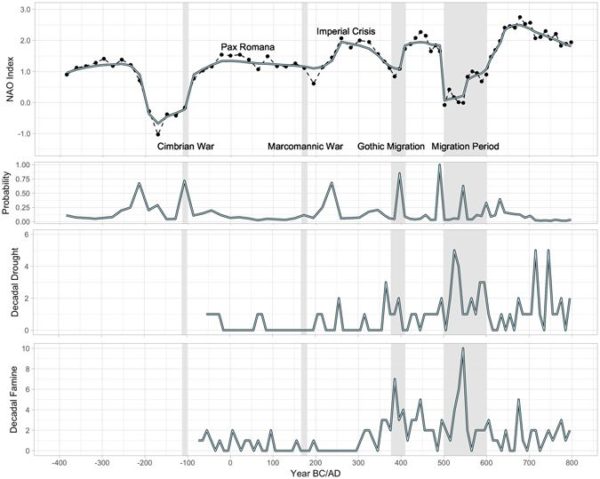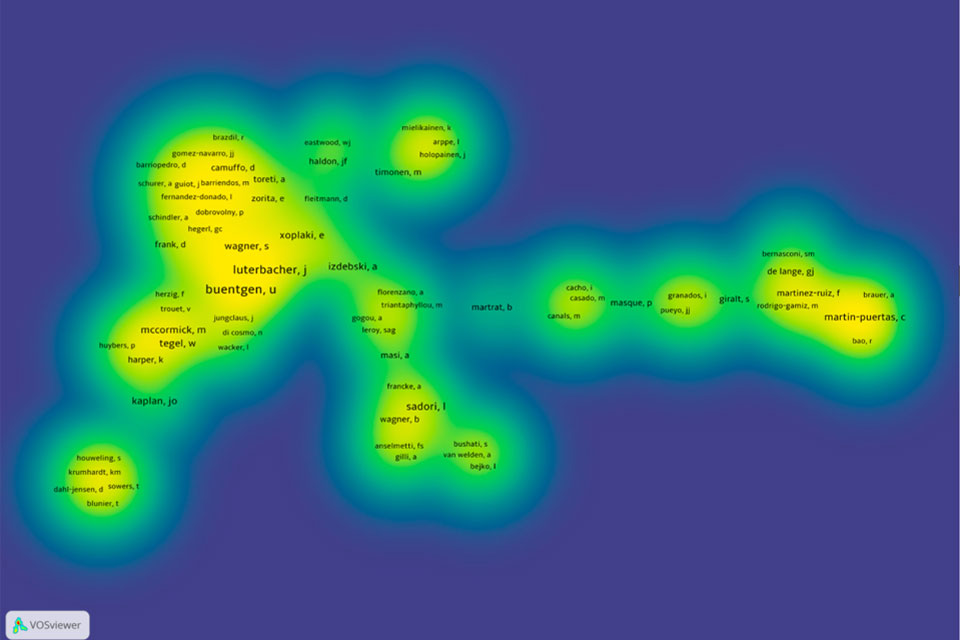The story of the Decline and Fall of the Roman Empire has in recent years been seen as a reflection of 4thcentury widespread draughts on the Eurasian Steppes, the wanderings of the Huns, and the forced migration of the Germans. The questions raised in an exceedingly important meta-study of the literature is to what extent the facts fit with the history?
REVIEW:
Climate and the Decline and Fall of the Western Roman Empire: A Bibliometric View on an Interdisciplinary Approach to Answer a Most Classic Historical Question
By Werner Marx, Robin Haunschild, and Lutz Bornmann.
In: Climate, Vol 6, No 5
Open Access

From: Changes in North Atlantic Oscillation drove Population Migrations and the Collapse of the Western Roman Empire. In: Nature (2017). Scientific reports Vol 7, Article No 1227
Most historians interested in the rigor mortis of the Late Antiquity and the transition to the Early Middle Ages have acquainted themselves with the ground-breaking work of Ulf Büntgen, and Michael McCormick outlining the calamitous climatic events following the Roman Optimum.
But what exactly are the facts behind these and several other studies published during the last decades? And how do we get an overview of what is firm evidence and what are suppositions? Enter the recent study by Werner Marx, Robin Haunschild and Lutz Bornmann, who has carried out something as exotic as a bibliometric analysis. About the method applied, they write in the abstract:
“Based on the Web of Science (WoS) database, we applied a combination of three different search queries for retrieving the relevant literature: (1) on the decline and fall of the Roman Empire in general, (2) more specifically on the downfall in connection with a changing climate, and (3) on paleoclimatic research in combination with the time period of the Roman Empire and Late Antiquity. Additionally, we considered all references cited by an ensemble of selected key papers and all citing papers of these key papers, whereby we retrieved additional publications (in particular, books and book chapters). We merged the literature retrieved, receiving a final publication set of 85 publications. We analyzed this publication set by applying a toolset of bibliometric methods and visualization programs.”
Such meta-studies are well known in the medical sciences, but to the best of my knowledge, this is the first time they have been applied to a humanistic field; and more specifically, one which is as contested as the one dealt with here. Scholars and scientists familiar with the questions about “The Decline and Fall” will know that positions range from historians claiming it never took place to those who believe the shifts were tectonic in nature. Thanks to the newly published article by Werner Marx and his co-authors, we can now get a solid overview of the debates, the climatic indicators and proxies, and the problems encountered by historians working in this relatively new field of research.
So what are the findings?
According to multiple studies of paleoclimatic data sets, a climatic shift did indeed occur sometime after the Roman Optimum, when a favourable climate was arguably decisive for the growth of the Roman Empire. This was caused by a solar maximum, which set in c. 150 BC. Sometime after AD 250–400, however, the climate turned unstable. The probable reason was the sun-induced melting of Arctic Ice, gradually depressing the Gulf Stream, which moves hot water from the Gulf of Mexico and Bermuda. We know that this probably contributes to a shift in the path of the upper atmospheric yet-streams – the so-called North Atlantic Oscillation – turning the climate into something like what we are currently experiencing in present-day Europe: Hot, and dry summers, followed by cold winters (with noticeable variations across the continent). Most of all, though, the weather turned increasingly volatile. “At the risk of oversimplifying”, the authors conclude that, yes, the climate archives reveal, there was indeed a Roman Climate Optimum, which was followed by a Migration Period Pessimum (a phrase first coined in 2008).
Exactly when this deterioration of climate set in, however, is somewhat contested. Some claim that this shift set in c. 150 and thus coincides with the Marcomanic Wars (AD 166 – 180), others ca. 250, and yet some scientists indicate ca. 400 as the tipping point. As the height of the migration period arguably set in during the 4th century, this has repercussions for the historians trying to argue for a series of climate-driven events, from The Marcomanic Wars to the crossing of the possibly frozen River Rhine on New Year’s Eve AD 406. Others claim a more fundamental convergence of events, cobbling the deterioration of the climate with severe droughts on the Eurasian Steppes, pushing in the 4th century the Huns to the frontiers of their habitat while propelling the Germanic people in front of them. But if the deterioration set in as late as ca. 400, this line of argument is faulted from the beginning.
The authors find that this lack of precise knowledge hampers the specific conclusions which may be reached and add: “We do not want to advocate for simple or reductionist theories – we do not know if the fluctuations of the climate were a triggering factor; the data only deliver a possible connection,” they prudently write. They are well aware that simple causality is impossible to outline, simply because the “Decline and Fall” took place over several centuries and involved multiple groups of different people reacting to as diverse climatic conditions as humid North Germania and an arid Mediterranean region. Having said that, the authors carefully call for more detailed interdisciplinary studies of how it all played out locally and temporally. History is the story of how people react to the events happening in their immediate surroundings. Among these, climatic events may be decisive. Not least when they present themselves in a pre-modern context as three or more years of prolonged excessive draught or humidity. To move ahead, we need more local studies of local climate change and changes in settlement patterns as those which, for instance, have been carried out in Sweden following the events of AD 536 or the studies by Armin Volkmann of the events in the Oder region in Northern Germany.
The Bibliometric Approach
Historians may enjoy this study for its precise and “cool” overview of the present status quo of the debate concerning the linkage between the “Climate” and the “Decline and Fall”. As the authors write, however, bibliometric approaches are also valuable because they avoid the bias involved in more traditional “state of the art” synopses of any literature, we are so familiar with. On the other hand, the method is hampered by the fact that humanistic scholars still seem to write books, which are not generally refereed in such large databases as WoS or Scopus. In the present study, though, this was compensated for by taking into consideration the bibliographic links in the ten most quoted articles and chapters in books, from which the 85 were recruited. The article is highly recommended.
Below is a list of the ten must-reads, which this important paper links to. The remaining 85 papers are listed in the article.
Karen Schousboe
READ MORE:
The Fate of Rome: climate, disease, and the end of an empire.
By A Moravcsik
In: ForeignAffairs97(1),160-160(2018)
Approaches to the environmental history of Late Antiquity, part II: Climate Change and the End of the Roman Empire.
By M. J. Decker
In History Compass (2017) vol 15, No 2.
Changes in North Atlantic Oscillation drove Population Migrations and the Collapse of the Western Roman Empire
By B. Lee Drake
In: Nature (2017). Scientific reports Vol 7, Article No 1227
Rome and the Classic Maya: Comparing the Slow Collapse of Civilizations
By Rebecca Storey and Glenn R Storey
Routledge 2017
The Environmental Fall of the Roman Empire
By Ken Harper
In: Dædalus (2016), Vol 145, No 2, pp. 101 -111.
The environmental, archaeological and historical evidence for regional climatic changes and their societal impacts in the Eastern Mediterranean in Late Antiquity
By Adam Izdebski, Jordan Pickett, Neil Roberts, and Tomasz Waliszewski.
In: Quaternary Science Reviews, Volume 136, p. 189-208.
Climate Change during and after the Roman Empire: Reconstructing the Past from Scientific and Historical Evidence
By Michael McCormick, Ulf Büntgen, Mark A. Cane, and Edward R. Cook,
In: Journal of Interdisciplinary History (2012) Vol 43, No 2, pp.169-220
2500 years of European climate variability and human susceptibility.
By U. Büntgen U, W. Tegel, K. Nicolussi, M. McCormick, D. Frank, V. Trouet, J. Kaplan F. Herzig, U. Heussner, H. Wanner, J. Luterbacher and J. Esper
In: Science (2011) 331: 578-582
Climate change and human history. Some indications from Europe, ad 400-1400.
By Neville Brown
In: Environmental Pollution (1994), Vol 83, No 1–2, pp. 37-4
Climatic Change and Agricultural Exhaustion as Elements in the Fall of Rome
Ellsworth Huntington
The Quarterly Journal of Economics (1917) Vol 31, No 2, pp. 173–208
READ ALSO:
FEATURED PHOTO:
Co-Authorship of all authors (435) from the 85 papers dealing with the fall of Rome or the time period of the Roman Empire in connection with climate change. © Werner Marx et all. Source: WoS/VOS Viewer
More LInks:


